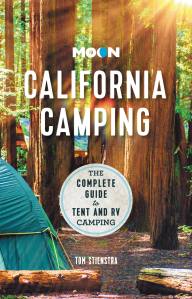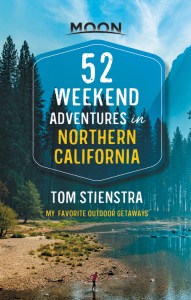Best Secluded Camping in California
Before embarking on your camping adventure, please check the California Department of Parks and Recreation website for information and updates regarding the status of campground openings.
California has some of the most beautiful campsites in the country, but getting a reservation can be a nightmare, with the reservation system usually booked months in advance. Three of these require reservations (you shouldn’t have to fight for them, but plan ahead!) and the other seven are first-come first-served and rarely visited. All ten are great campsites that will earn you membership into what author Tom Stienstra calls the 5 Percent Club: pristine, quiet spots where less than 5% of campers camp.

Secluded Camping in Northern California
Mattole (King Range National Conservation Area)
Region: Redwood Empire
Scenic rating: 8/10
The Lost Coast is often overlooked by visitors because of the difficulty in reaching it; your only access is via a slow, curvy road through the Mattole River Valley, past Petrolia, and out to a piece of coast. The experience is like being in suspended animation—your surroundings peaceful and pristine, with a striking lack of people. One of the best ways to capture the sensation is to drive out near the mouth of the Mattole, then hike south on the Coastal Trail long enough to get a feel for the area.
This is a little-known camp set at the mouth of the Mattole River, right where it pours into the Pacific Ocean. It is beautiful and isolated. An outstanding hike leads to the Punta Gorda Lighthouse. Hike from the campground to the ocean and head south. It’s a level walk, and at low tide, there’s a chance to observe tidepool life. Perch fishing is good where the Mattole flows into the ocean, best during low tides. In the winter, the Mattole often provides excellent steelhead fishing. Check the Department of Fish and Game regulations for closed areas. Be sure to have a full tank on the way out—the nearest gas station is quite distant. Leashed pets are allowed, some facilities are wheelchair-accessible.

Crater Lake (Lassen National Forest)
Region: Lassen and Modoc
Scenic rating: 8/10
This hideaway near Crater Lake rests at 6,800 feet elevation in remote Lassen National Forest, just below Crater Mountain (that’s it up there to the northeast at 7,420 feet). This 27-acre lake provides trout fishing, boating (gas motors are discouraged), and, if you can stand the ice-cold water, a quick dunk on warm summer days. Leashed pets are allowed.
Sinkyone Wilderness (Sinkyone Wilderness State Park)
Region: Mendocino and Wine Country
Scenic rating: 10/10
This is a great jumping-off point for a backpacking trip in the Sinkyone Wilderness on the Lost Coast, one of the few wilderness areas where a trip can be made any month of the year. The terrain is primitive, steep, and often wet, but it provides a rare coastal wilderness experience. Starting at the northern trailhead at Orchard Camp, or the southern trailhead at the Usal Beach campground, it’s an ambitious weekend tromp of 17 miles. This is a unique 7,367-acre park that is named after the Sinkyone tribe, which once lived in this area. It is called the Lost Coast because no highways provide direct access. Regardless, it has become surprisingly popular for backpackers on the California Coastal Trail. Drinking water is available at the visitors center.
Newsletter Signup
By clicking ‘Sign Up,’ I acknowledge that I have read and agree to Hachette Book Group’s Privacy Policy and Terms of Use
Utica and Union Reservoirs (northeast Arnold, Stanislaus National Forest)
Region: Tahoe and Northern Sierra
Scenic rating: 10/10
These twin reservoirs are set in Sierra granite at 6,850 feet. Union is a beautiful and quiet lake that is kept that way with rules that mandate a 5-mph speed limit. Utica does not allow motors of any kind. Most of the campsites provide lakeside views. Fishing is often good—trolling for kokanee salmon—but you need a boat. The setting is great, especially for canoes or other small boats. This area was once a secret, but alas the secret is out and there are now three new, small campgrounds around the water’s edge. Remember to bring pack water in with you, as there is no potable water onsite. Leashed pets are allowed.
Angel Island State Park Walk-In/Boat-In
Region: San Francisco Bay
Scenic rating: 10/10

Camping at Angel Island is one of the unique adventures in the Bay Area; the only catch is that getting to the campsites requires a ferry boat ride and then a walk of 1-2 miles, or a kayak or boat trip from the mainland directly to the camp. The payoff comes at the end of the day, when all of the park’s day visitors depart for the mainland, leaving the entire island to you.
This is one campsite that it pays to be prepared; book far ahead because the sites can book up months in advance. The group camp is popular with kayakers because of beach access. From start to finish, it’s a great trip, featuring a private campsite, often with spectacular views of San Francisco Bay, the San Francisco waterfront and skyline, Marin Headlands, and Mount Tamalpais. The tromp up to 798-foot Mount Livermore includes a short, steep stretch, but in return furnishes one of the most spectacular urban lookouts in America. Be ready for cold, foggy weather at night in midsummer. The park features more than 13 miles of trails, including Perimeter Road, a must-do for all avid cyclists. Bikes are also permitted on the park’s fire road system. Angel Island has a stunning history, including being used from 1910 to 1940 to process thousands of immigrants as they entered America; historic tram tours are available.
Secluded Campgrounds in Southern California
Mono Hike-In (Mono Creek, Los Padres National Forest)
Region: Santa Barbara and Vicinity
Scenic rating: 7/10
Not many folks know about this spot, so if you’re looking for a quiet, relaxing weekend, this is the spot for you. The camp is small and primitive, at 1,500 feet elevation on little Mono Creek, but Little Caliente Hot Springs is only one mile northeast of the campground. Mono Creek is a feeder to Gibraltar Reservoir, a long, narrow lake with no direct access.
Remember to pack in enough water for your whole trip, as there is no potable water onsite.
Santa Rosa Island (Channel Islands National Park)
Region: Santa Barbara and Vicinity
Scenic rating: 10/10
Santa Rosa, the second-largest of the Channel Islands (the largest is Santa Cruz), is 10 miles wide and 15 miles long, and it holds many mysteries and adventures. A camping trip to Santa Rosa Island, available Friday through Sunday, will be an unforgettable experience even for those who think they’ve seen it all. The island is beautiful in the spring, when its grasslands turn emerald green and are sprinkled with wildflowers. There are many good hikes: The best is the Cherry Canyon Trail into the island’s interior. Another great one is the five-mile Torrey Pines Trail. The Lobo Canyon Trail is a personal favorite.
Because the boat ride to Santa Rosa is approximately 2.5 hours, longer than the trip to Santa Cruz, this island often receives fewer visitors, which makes it even more special. Bring warm clothes because of the chance of fog and wind. The back beaches and sand dunes between Skunk Point and East Point are closed to hiking March through mid-September to protect nesting habitat for the snowy plover. The coastline around Sandy Point is closed year-round to protect seal rookeries.

Two Harbors (Catalina Island)
Region: Los Angeles and Vicinity
Scenic rating: 10/10
This campground is only a quarter-mile hike away from the village of Two Harbors. Nearby attractions include the Two Harbors Dive Station with snorkeling equipment, paddleboard rentals, and scuba tank fills to 3,000 psi. There are guided tours of the island and a scheduled bus service between Two Harbors and Avalon; a shuttle bus stops at all the interior campgrounds. An excellent hike is the nine-mile round-trip from Two Harbors to Emerald Bay, featuring a gorgeous coast and pretty valleys. The ferry to Avalon is available from Long Beach, Dana Point, or San Pedro. The ferry to Two Harbors is available only from San Pedro. Once at Avalon, there is a Safari Bus (310/510-2800, $16-25 one-way) to Two Harbors.
Hermit Gulch (Avalon, Catalina Island)
Region: Los Angeles and Vicinity
Scenic rating: 10/10
This is the closest campground to the town of Avalon, the gateway to Catalina. Reaching the camp requires a 1.5-mile hike up Avalon Canyon. If you’re making a tourist trip, there are a ton of things to do: visit Avalon’s underwater city park, play the nine-hole golf course, rent a bicycle, or visit the famous casino. Scenic tours, glass-bottomed boat tours, and Wrigley Memorial and Botanical Gardens are available. Fishing can be excellent, including angling for white seabass, yellowtail, and, in the fall, even marlin. The best hiking experience in the Avalon area is found by taking the shuttle bus to the Airport in the Sky and from there hiking along Empire Landing Road. The route traces the island’s curving, hilly northern shore, providing great views of secluded beaches, coves, and rock formations, and a chance to see wildlife, at times even buffalo. Note that free hiking permits are required.

Newsletter Signup
By clicking ‘Sign Up,’ I acknowledge that I have read and agree to Hachette Book Group’s Privacy Policy and Terms of Use
Pin For Later



